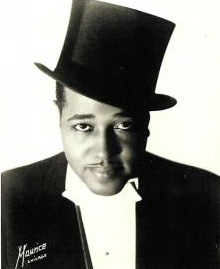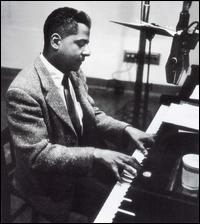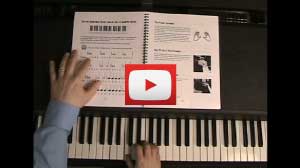Swing Era Pianists:
Duke Ellington, Count Basie, Teddy Wilson, Earl Hines and Art Tatum
Swing era pianists changed jazz piano from being mostly a solo instrument singly playing the melody, harmony and rhythm; to being one of the parts of the jazz orchestra. Because the bands had both a bassist and drummer, the pianists could leave the steady left-hand rhythm of the stride age behind. This gave the swing era pianists more freedom rhythmically with their approach to the chords, and allowed them to play more sparsely and lightly. They could just fill in the gaps of the big band horn arrangement, or add light touches floating on top of the orchestra.
The strong physicality of the stride age was being replaced with the elegance and restraint of the swing era pianists.
Edward "Duke" Ellington, 1899-1974

Edward Kennedy Ellington earned his nick name "Duke" because as a young man in Washington D.C., he was a "dapper dresser" with articulate diction and a forthright manner. As a teenager he was more interested in art than music, but by 1918, "Duke" was one of the top pianists in D.C. He met Fats Waller who convinced him to go to New York in 1923. He was good enough to keep up with the stride players on the rent party circuit, and soon started his own band.
In 1927, Ellington was the bandleader for the house band at Harlem's Cotton Club, providing music and writing arrangements for dancers, comediens, jugglers and singers. He soon had a weekly radio show, which made him a national star. By the 30's, The Duke Ellington Orchestra was touring the U.S.
Though Duke was a strong stride player, his style was to serve the song and arrangement. He played with reserve, preferring to put the spotlight on his band members. His piano playing "filled the holes" in his arrangements. His longtime friend and collaborator Billy Strayhorn said "Duke played the piano, but his real instrument is the orchestra."
Duke Ellington used the piano to set the rhythm of the orchestra, and on ballads to highlight the sensitivity of the arrangement. The piano was a composing tool, which he used to write pieces designed specifically for the individual personalities of the musicians in his orchestra, many of whom stayed with Duke for decades.
Duke Ellington had a distinctive elegant and restrained piano style. He will be remembered not only for being one of the best swing era pianists, but also for his many songs, innovations, concert works and as possibly the most important musician in American history.
William "Count" Basie, 1904-1984
William Basie, whom his friends called "Bill," grew up in Red Bank, N.J., and first learned how to play piano from his mother. He moved to New York by his late teens, and became friends with and learned from James P. Johnson and Fats Waller. He was touring with vaudeville acts before he was 20; working as a solo pianist, accompanist to dancers, blues singers and comedians and as musical director. This gave Basie a great practical training.
In 1927, one of those tours fell apart and left him stranded in Kansas City. Kansas City was a wild town with hundreds of bars and nightclubs, and lots of work for musicians. He stayed there, first working as an accompanist to silent pictures, then joining Walter Page's Blue Devils.
By 1935, Basie had started his own band, a 9 piece outfit that played blusey "head" arrangements. The gained notoriety with a weekly radio broadcast, which promoter John Hammond heard in '36. Hammond brought them to New York and later the gained international recognition with "One O'Clock Jump," and "Jumpin' At The Woodside." Count Basie became the most recognizable swing era pianist with his light touch and trade mark three-note ending.
The band was forced to disband in 1950, but he managed to build a new band in 1952 with a new, more sophisticated sound that kept his career going strong as an elder statesman of jazz up until his death in 1984.
Teddy Wilson, 1912-1986

Teddy Wilson grew up in Tuskegee, Alabama, the son of intellectual parents. He studied music at Talladega College, and later moved to Chicago where got a gig with Louis Armstrong.
For a short time he lived in Toledo Ohio, replacing Art Tatum in a band. They both lived in the same building, became friends and influenced each other's playing.
In 1933 he moved to New York and by 1935 he had met Benny Goodman. Promoter John Hammond convinced Goodman to put together a small group including Wilson, making it the first major mixed race musical group in America. Hammond also paired Wilson with singer Billie Holiday and Tenor sax great Leaster young on many recording sessions.
In 1940 Teddy Wilson put together his own big band, but after difficulty finding success, he had to fold it in '42. He later played in small groups and occasionally toured with Benny Goodman. He taught briefly at Julliard Conservatory, being the first to bring jazz into that institution.
Teddy Wilson had a percussive left hand style, utilizing single-note right-hand lines with a cool legato feel. He was comfortable in a band setting, or as a soloist, with a poised and restrained approach to swing piano.
Earl "Fatha" Hines, 1903-1983
Earl Hines began taking piano lessons at the age of 9, and became an excellent reader who loved playing the classical repertoire. He also loved to play ragtime, and began experimenting with the new music called "jazz."
By 1923 Earl had made his first recording and would later record with Louis Armstrong's Hot Five, making some of the most important early jazz on record.
Earl Hines was comfortable playing in a band or alone, and would make some innovations that would forever change jazz piano. He developed a "trumpet" single note lead style in an effort to be heard in a band setting. This left behind the ragtime chordal approach for the right hand. His left hand played a more syncopated rhythmic attack with chords, leaving the steady "1-2-3-4" beat to the bass and drums.
Throughout his storied career Earl had opened night clubs, had a radio program, toured the world, and made some of the greatest jazz piano recordings. He also led a big band that would become the incubator for bop. His band featured future greats including Charlie Parker, Dizzy Gillespie, Billy Ekstine and Sarah Vaughan. Unfortunately, the band never recorded because of an on-going recording strike in the 40's.
Earl Hines, a true innovator swing era pianist, settled in San Francisco, where he died in 1983.
Art Tatum, 1909-1956
Although Art Tatum was a swing era pianist, he is not really remembered as a "swing" pianist, but a jazz pianist beyond category. Art was blind in one eye and sight impaired in the other. He was trained at the Toledo School of Music, where he learned to read with glasses and also with the Braille method. He also taught himself by playing along with piano rolls of James P. Johnson and Fats Waller, whom he called his greatest influence.
Art was playing professionally in Toledo by 1929, and in 1932 he went to New York as blues singer Adelaide Hall's accompanist. Though he already had a reputation as a top rate pianist, he felt intimidated, and returned to Toledo. He made his first solo recording in '33, and by '37, he was ready to return to New York.
Art Tatum had a reputation for finding a piano in any "dive," and playing all night. He could play any song he heard at least once, and play it in any key. For a while he had a trio, inspired by Nat "King" Cole, featuring Tiny Grimes on guitar and Slam Stewart on bass. Though he did much work in band settings, he was most comfortable as a solo performer, where he had complete freedom to play all parts of a song, and not hold anything back.
In 1953, art began an association with Norman Granz, and made a series of oustanding recordings. Tatum is best known for his exquisite treatment of standards, but he was also a great blues player, which he always found his way to during those long late night jams.
Art Tatum remained active right up until his death in 1956. He will be remembered as one of the greatest pianists in jazz.
Start Playing Piano Today with the Piano Guide Quick Start Course!
Easy to follow step-by-step lessons designed for adult beginners. The next best thing to private lessons!
What You'll Learn:
- Notes on the piano/keyboard
- Proper fingering
- C major scale
- Chords
- How to read music
- And much more!

Video lessons - watch as I play everything for you.

